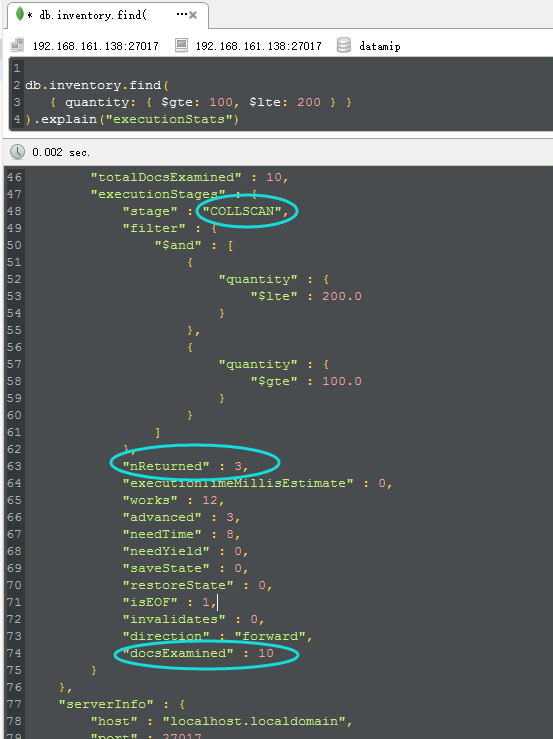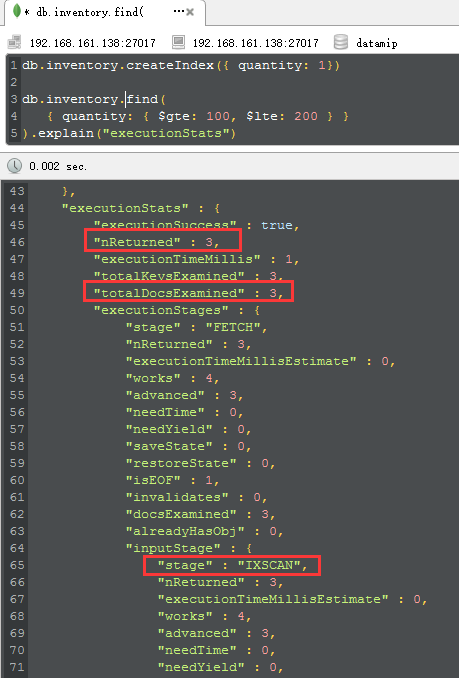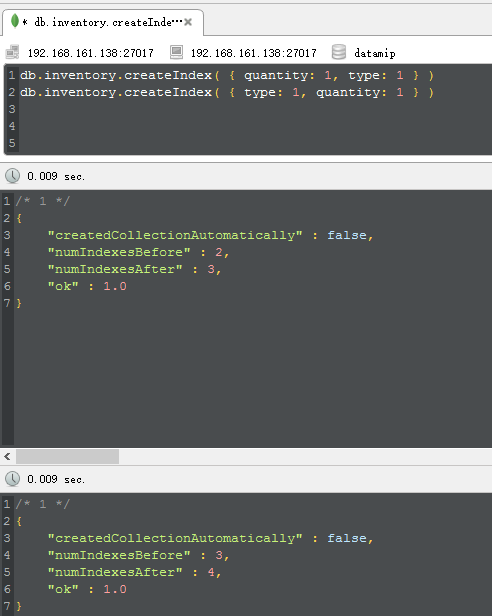當你第一眼看到explain和hint的時候,第一個反應就是mysql中所謂的這兩個關鍵詞,確實可以看出,這個就是在mysql中借鑑過來的,既然是借鑑
過來的,我想大家都知道這兩個關鍵字的用處,話不多說,速速觀看~~~
一:explain演示
1. 構建資料
為了方便演示,我需要create ten data to inventory,而且還是要在no index 的情況下,比如下面這樣:
1 db.inventory.insertMany([ 2 { "_id" : 1, "item" : "f1", type: "food", quantity: 500 }, 3 { "_id" : 2, "item" : "f2", type: "food", quantity: 100 }, 4 { "_id" : 3, "item" : "p1", type: "paper", quantity: 200 }, 5 { "_id" : 4, "item" : "p2", type: "paper", quantity: 150 }, 6 { "_id" : 5, "item" : "f3", type: "food", quantity: 300 }, 7 { "_id" : 6, "item" : "t1", type: "toys", quantity: 500 }, 8 { "_id" : 7, "item" : "a1", type: "apparel", quantity: 250 }, 9 { "_id" : 8, "item" : "a2", type: "apparel", quantity: 400 }, 10 { "_id" : 9, "item" : "t2", type: "toys", quantity: 50 }, 11 { "_id" : 10, "item" : "f4", type: "food", quantity: 75 }]);

2. 無索引查詢
db.inventory.find( { quantity: { $gte: 100, $lte: 200 } } ).explain("executionStats")

從上圖中,我們看到了三個圈圈,這些都是我們在find中非常重要的資訊,具體資訊解釋如下:
<1>COLLSCAN
這個是什麼意思呢? 如果你仔細一看,應該知道就是CollectionScan,就是所謂的“集合掃描”,對不對,看到集合掃描是不是就可以直接map到
資料庫中的table scan/heap scan呢??? 是的,這個就是所謂的效能最爛最無奈的由來。
<2> nReturned
這個很簡單,就是所謂的numReturned,就是說最後返回的num個數,從圖中可以看到,就是最終返回了三條。。。
<3> docsExamined
那這個是什麼意思呢??就是documentsExamined,檢查了10個documents。。。而從返回上面的nReturned。。。
ok,那從上面三個資訊中,我們可以得出,原來我examine 10 條資料,最終才返回3條,說明做了7條資料scan的無用功,那麼這個時候問題就來了,
如何減少examine的documents。。。
完整的plans如下:

/* 1 */ { "queryPlanner" : { "plannerVersion" : 1, "namespace" : "datamip.inventory", "indexFilterSet" : false, "parsedQuery" : { "$and" : [ { "quantity" : { "$lte" : 200.0 } }, { "quantity" : { "$gte" : 100.0 } } ] }, "winningPlan" : { "stage" : "COLLSCAN", "filter" : { "$and" : [ { "quantity" : { "$lte" : 200.0 } }, { "quantity" : { "$gte" : 100.0 } } ] }, "direction" : "forward" }, "rejectedPlans" : [] }, "executionStats" : { "executionSuccess" : true, "nReturned" : 3, "executionTimeMillis" : 1, "totalKeysExamined" : 0, "totalDocsExamined" : 10, "executionStages" : { "stage" : "COLLSCAN", "filter" : { "$and" : [ { "quantity" : { "$lte" : 200.0 } }, { "quantity" : { "$gte" : 100.0 } } ] }, "nReturned" : 3, "executionTimeMillisEstimate" : 0, "works" : 12, "advanced" : 3, "needTime" : 8, "needYield" : 0, "saveState" : 0, "restoreState" : 0, "isEOF" : 1, "invalidates" : 0, "direction" : "forward", "docsExamined" : 10 } }, "serverInfo" : { "host" : "localhost.localdomain", "port" : 27017, "version" : "3.2.8", "gitVersion" : "ed70e33130c977bda0024c125b56d159573dbaf0" }, "ok" : 1.0 }
3. 使用single field 加速查詢
知道前因後果之後,我們就可以進行鍼對性的建立索引,比如在quality欄位之上,如下:
db.inventory.createIndex({ quantity: 1})
db.inventory.find(
{ quantity: { $gte: 100, $lte: 200 } }
).explain("executionStats")

好了,這時候就有意思了,當我們執行完createindex之後,再次explain,4個重要的parameters就漂下來了:
<1> IXSCAN
這個時候再也不是所謂的COLLSCAN了,而是IndexScan,這就說明我們已經命中索引了。
<2> nReturned,totalDocsExamined,totalKeysExamined
從圖中可以看到三個引數都是3,這就說明我們的mongodb檢視了3個key,3個document,返回3個文件,這個就是所謂的高效能所在,對吧。
二:hint演示
說到hint,我想大家也是知道的,很好玩的一個東西,就是用來force mongodb to excute special index,對吧,為了方便演示,我們做兩組複合索
引,比如這次我們在quality和type上構建一下:

building完成之後,我們故意這一個這樣的查詢,針對quantity是一個範圍,而type是一個定值的情況下,我們force mongodb去使用quantity開頭
的複合索引,從而強制mongodb give up 那個以{type:1,quantity:1}的複合索引,很有意思哦,比如下圖:

從圖中,可以看到,我們檢查了6個keys,而從最終找到了2個文件,現在我們就知道了,2和6之間還是有不足的地方等待我們去優化了,對吧,下面
我們不hint來看一下mongodb的最優的plan是怎麼樣的。

再看上面的圖,你應該明白了,mongodb果然執行了那個最優的plan,是不是很好玩,好了,本篇就說到這裡,希望對你有幫助~
